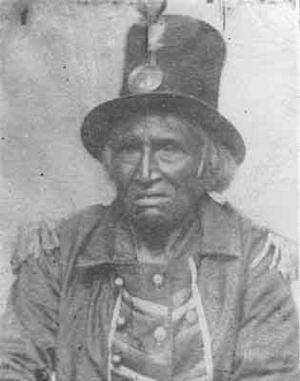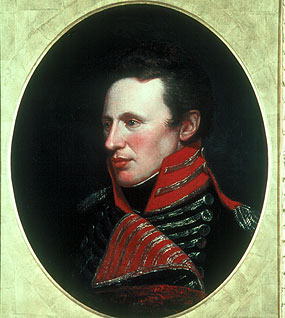Tamaha (Dakota scout) facts for kids
Tamaha (born around 1776, died 1864) was a brave Mdewakanton Dakota man. He was also known as Standing Moose. Tamaha was one of only two Dakota scouts who helped the United States during the War of 1812. This was special because most Sioux people supported the British at that time.
Tamaha was part of Chief Red Wing's group. For his loyalty to the U.S., Governor William Clark of Missouri Territory gave him a medal and a special paper. Tamaha really valued this paper. He even called himself "the 'only' American Sioux." You can see this important paper today at the Minnesota History Center.
In 1805, a 26-year-old explorer named Zebulon Pike called Tamaha "my friend" in his journal. This helped make Tamaha famous. A place called Tahama Spring in Colorado Springs is named after him.
Contents
Tamaha's Early Life
Tamaha was born in a place called Prairie à l'Aile. Today, this area is known as Winona, Minnesota. He was first part of Chief Wabasha's group.
Many exciting stories are told about Tamaha when he was young. A writer named Charles Eastman described him as a very strong young man. He said Tamaha was an amazing runner. He had all the physical skills of a great athlete. Eastman wrote that Tamaha looked like a beautiful statue in his simple clothes.
When Tamaha was seventeen, he had an accident. He lost one of his eyes. Because of this, many people called him the "one-eyed Sioux." French Canadians also called him "Le Borgne," which means "The One-Eyed."
Eastman said that losing his eye made Tamaha even more daring. He started to seek out danger. Once, young Tamaha and his best friend dressed up like Ojibwe warriors. They did this to meet Ojibwe girls. Another time, he was hunting buffalo. A bull threw him off his horse and attacked him. Tamaha quickly jumped onto the buffalo's neck. He held onto its horns. This brave act earned him the name "Held-the-Bull-by-the-Horns."
Eastman also shared a famous quote from Tamaha. It was during his adventure running from the Ojibwe. Tamaha told his friend, "I'll meet you at the mouth of the St. Croix River, or in the spirit land!"
Friendship with Explorer Zebulon Pike
In his journal, Lieutenant Zebulon Pike wrote about Tamaha many times. He called him "Le Original Leve." This was a French way of saying "L'Orignal Levé," which means "Standing Moose." Pike also noted that "Le Orignal Levé" was known as "Tahamie" and "Rising Moose."
On September 23, 1805, Pike met with a group of Dakota leaders. He wanted to make a deal to get land for a military base. Pike wrote that seven Sioux "chiefs" came to this meeting. "Le Original Leve" was listed as a "war chief." Historians say that not all of them were true chiefs to the Dakota people. Only two of the seven Sioux signed the land agreement. This agreement is known as Pike's Purchase. They agreed to give up about 100,000 acres of land. The United States Department of War later built Fort Snelling there.
Pike also wanted the Dakota to make peace with the Ojibwe. He wrote that the Dakota leaders promised safe travel for the Ojibwe. They said they would talk about peace. But Pike thought peace was unlikely. In a letter, Pike wrote that "Elan Levie" (Tamaha) promised loyalty to the U.S. from six Sioux villages. He said, "A chief by the name of Elan Levie, then told me to look round on those young warriors on the beach; that not only they, but those of six villages more, were at our command."
The next morning, Pike was very upset. His American flag was missing from his boat. He told Tamaha, whom he called "my friend," how angry he was. Pike showed his anger by punishing one of his guards. He also sent people to search for the flag.
Tamaha in the War of 1812
Tamaha was one of the few Sioux people who actively supported the United States during the War of 1812.
He stayed loyal even after the British captured him. They threatened to kill him if he told them anything about the Americans. But Tamaha refused to share any information. Luckily, the threat was just a bluff.
Peace Medal and Loyalty Papers
Because Tamaha was so loyal to America, he received a Peace Medal and special loyalty papers. These were given to him by William Clark. You can see these important papers at the Minnesota History Center. Tamaha carried these papers with him everywhere. He would even charge people a small fee to see them!
Against the Dakota War of 1862
Tamaha always wore his special stovepipe hat. He strongly believed that white people (especially Americans) and Indians should get along. Before the Dakota War of 1862, Tamaha spoke to Little Crow. He advised him not to go to war against the white settlers.
Death
Tamaha passed away in 1864, after the Dakota War. According to Charles Eastman, he died at Fort Pierre, South Dakota.



